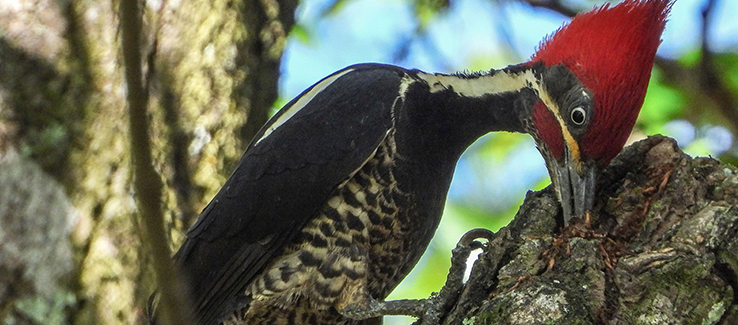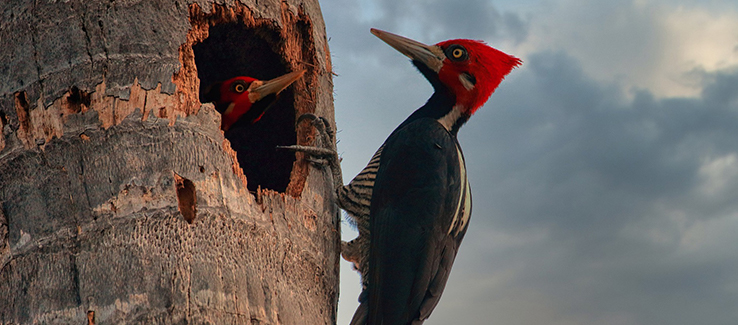
Don’t let the non-stop pounding of a woodpecker get under your skin. Knowing how woodpeckers interact with and use trees will help you further understand them.
fasttreeremovalatlanta.com gathered information on the impact woodpeckers have on trees, how they look for food, and their nesting or roosting habits.
Do Woodpeckers Damage Trees?
Not exactly. Healthy trees are capable of withstanding the minor damage woodpeckers can cause unless the targeted trunks or limbs receive girdling injuries (extremely rare).
Woodpeckers have a preference for dead trees or trees with rotting heartwood to create their nest cavities. When suitable trees aren’t available, some woodpeckers will peck holes in wooden siding, fence posts, and utility poles.
Some woodpecker species will drum on siding, on metal components of houses, or just about anything that makes noise as a part of their territorial and reproductive behaviors.
My Tree is Riddled with Holes
Elevated numbers of random holes in a tree’s trunk, branches, or stems may be a symptom of a declining tree already hosting numerous populations of insects. Holes in a tree trunk are not always perpetrated by woodpeckers. In many cases, wood-boring insects are to blame. In fact, woodpeckers rarely do any damage to trees unless there is already damage occurring.
Dispel the myth and understand that woodpeckers do not eat trees. They eat wood-boring insects and insect larvae from under the tree bark. If they are hammering away on a tree, specifically in the winter, there is a high probability that the tree is already infested beneath the bark with some kind of burrowing insect.
Woodpecker Diet
Woodpeckers are omnivores, and their diet consists almost entirely of insects but includes berries, nuts, and seeds rounded up from trees and shrubs. Some species feed on ground insects like ants. Woodpeckers provide great service to gardeners and property owners by voraciously seeking and eating insects harmful to trees like boring insect species and bark lice.
Note: It is not uncommon to see squirrels scratching away at tree bark in the same location where a woodpecker was pecking. They share an appetite for boring insect larvae growing beneath the bark.
Read more about boring insects at fasttreeremovalatlanta.com/tree-boring-insects
Woodpecker Feeding Habits
When foraging for insects, woodpeckers tend to focus on diseased, dying, or rotting trees. Woodpeckers are capable of drilling anything from rows of tiny holes to huge craters into tree wood, utility poles, and on occasion, houses as they seek their meal.
Drumming
Drumming is the name given to a woodpecker’s habit of hammering loudly, rapidly, and seemingly non-stop on a resonating surface, like a declining or dying tree, a traffic sign, a chimney, or even a house’s siding.
Woodpeckers do not sing like other birds. So, this drumming may be the bird’s way of communicating its territory and may also serve to attract a suitable mate. Males and females are both known to drum.
If the birds are drumming for these reasons, they will likely stop once breeding begins in the spring. Also, they don’t drum when looking for food (unless drilling to capture insect larvae).
Roosting and Nesting

Woodpeckers typically roost and nest in cavities. As day gives way to night, woodpeckers will seek out roosting cavities in either old abandoned holes or a cavity they excavated specifically for their roosting purposes.
They excavate nesting holes when their breeding season begins, typically in mid to late April and through May. Both nesting and roosting cavities are usually slightly larger than the width of the bird and will be either rounded, rectangular, or gourd-shaped.
Woodpeckers are very picky when selecting sites for their roosting and nesting holes, tending to favor dead trees or snags that offer a hard outer shell with a soft inner cavity.
Woodpecker Damage Prevention
Woodpecker damage to homes can be prevented or eliminated with multiple non-lethal techniques, including visual repellents, loud noises, and giving them nesting boxes. Immediate action is required to reduce this damage because woodpeckers are territorial and not easily driven away from their territories or pecking sites once established.
Woodpeckers and Trees
In this article, you discovered how woodpeckers impact trees, how they forage for food, their diet, and their roosting and nesting habits.
Understanding the pest control value woodpeckers offer in an ecosystem may encourage you to attract more of them to your region.
Trying to scare off or deter woodpeckers from roosting or nesting in your neighborhood can come with severe consequences as these birds are voracious insect predators.
Sources:
extension.psu.edu/do-woodpeckers-damage-your-trees
extension.colostate.edu/topic-areas/natural-resources/preventing-woodpecker-damage-6-516/
birds.cornell.edu/wp_about/biology.html
(404) 220-9965
(404) 220-9963
To view the orignal version of this post, visit: https://www.fasttreeremovalatlanta.com/are-woodpeckers-bad-for-trees

No comments:
Post a Comment